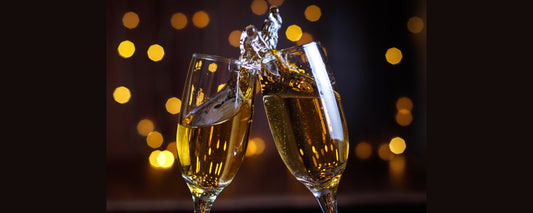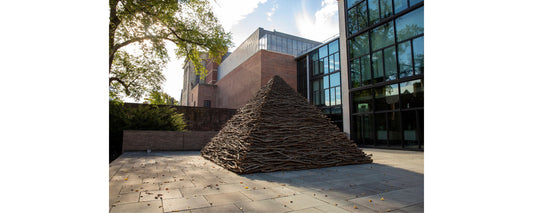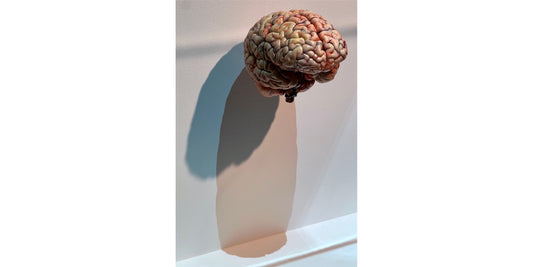A cold draft runs from the wide open garage door at the back of Ray Mathews’s glassblowing studio through the door in the front shop. But closer to the 2,000-degree gas-fired furnace, it’s plenty warm. A huge exhaust fan roars. Discarded glass in a bucket pops. The whole place feels a little bit dangerous.
In fact, it was the element of danger that first drew Mathews to glassblowing. While studying for a degree in art education at Southern Connecticut State University, he went with a friend to the school’s new glassblowing studio. His friend instructed him to reheat a piece he was working on in the furnace. “I went and slid it into the furnace, and unfortunately, the glass was too cold,” Mathews recalls. “So it exploded inside the furnace… It was exciting.” After that, he says, he had to take the course.
sponsored by
Two or three glassblowing classes later, Mathews graduated, and he and three partners built a studio at Bittersweet Farms, a former artists’ co-op in Branford. That partnership dissolved long ago, but 40 years later, Mathews is still at it. Located since 2015 in an industrial plaza off School Ground Road in Branford, his studio is part retail shop, part workspace, with one big furnace that runs 24/7 and two smaller ones for reheating glass as it’s being worked. Two benches are flanked by parallel rails, where a metal rod—either a solid “punty” or a hollow “blowpipe”—holding a clot of molten glass on its tip is rolled as the glass is shaped. A metal work table holds tools and containers of chipped colored glass.
Today Brian McCarthy, a former student and experienced glassblower, is busy crafting decorative glass eggs—solid, colorful forms, each with a bubble of air preserved inside. McCarthy opens the big furnace and dips his blowpipe into the crucible, then draws out an orange, glowing glob. The egg shape is formed by rolling the malleable glass in a wooden mold that’s kept cool and wet in a trough of water beside the bench. McCarthy reheats the newly shaped egg, still on the end of the blowpipe, in one of the smaller furnaces, then rolls it through a spread of colored glass chips. Next time the piece comes out of the heat, McCarthy blows into one end of the pipe, forming the bubble inside the egg. He takes several trips between furnace and bench to perfect the piece. Then he uses a “jack”—like a large pair of tongs—to begin separating it from the shaft. A final tap does the trick. The egg falls onto a padded surface, and a blow torch finishes its polish. Then the egg goes in a 900-degree oven to begin its long, slow cool to room temperature.
“A whole bunch of glass blowing is timing,” McCarthy says. “If it gets too cold, you can’t do anything. If it’s too hot, it drips on the floor.”
Mathews’s project for the day is a bit more unusual: a heart-shaped glass pendant that contains the ashes of someone’s deceased loved one, pressed into the super-heated glass much as the colored chips are. Outside the furnace, the pendant shines cobalt blue; inside, it takes on a fiery red hue. Mathews follows much the same process as McCarthy, finishing his piece by embedding a copper bail so the pendant can be worn as a necklace.
You never really stop learning, Mathews says. He plunges his hand in the trough of cool water and pulls out a “footing tool”: two pieces of wood that, pressed together, fashion the base of a wine glass. “For 41 years I’ve been struggling,” he says, demonstrating the way he’d always slip his fingers awkwardly between the pieces to make it work. “Three weeks ago, I inserted a spring.” He snaps the spring-loaded parts to show how well it works. “I’m still working on my stemware,” he adds.
Mathews is perhaps best known for his glass putters: golf clubs with unique glass heads. The novel idea was born in the late 1990s when Mathews told his father he probably wouldn’t make it for his annual visit to go golfing. “I said, ‘Dad, I’ve got so much glass to do, I don’t know if I’m going to make it this year.’ His comment was, ‘Too bad you can’t make golf clubs out of glass.’” This prompted Mathews to grind the edge of a glass paperweight and make his first putter, which he admits was “pretty ugly.” But his father played with it and showed it to a golf pro, who liked the way it handled. Eventually Mathews created a mold in order to standardize the putter heads, and he continues to sell them today.
The afternoon is waning as several students—all adults—show up and take to the studio. In addition to teaching and supporting these regulars as they work on their own, Mathews also gives beginners instruction in private groups, including kids over 12 if they come with their parents. Anyone can show up and watch from the safety of the front shop.
There, multicolored glass vases, ornaments and, of course, glasses stand in a kaleidoscopic array on mirrored shelves. Perfume bottles capture the sparkle of bright windows and golden lightbulbs. Every piece is delicate. But they’re durable, too, born in fire and built to last.
Ray’s Glassblowing Studio
59 School Ground Rd, Branford (map)
Open studio: Sat-Sun 10am-3pm
Classes: by appointment
(203) 488-9707
www.mathewsartglass.com
Written and photographed by Kathy Leonard Czepiel.








